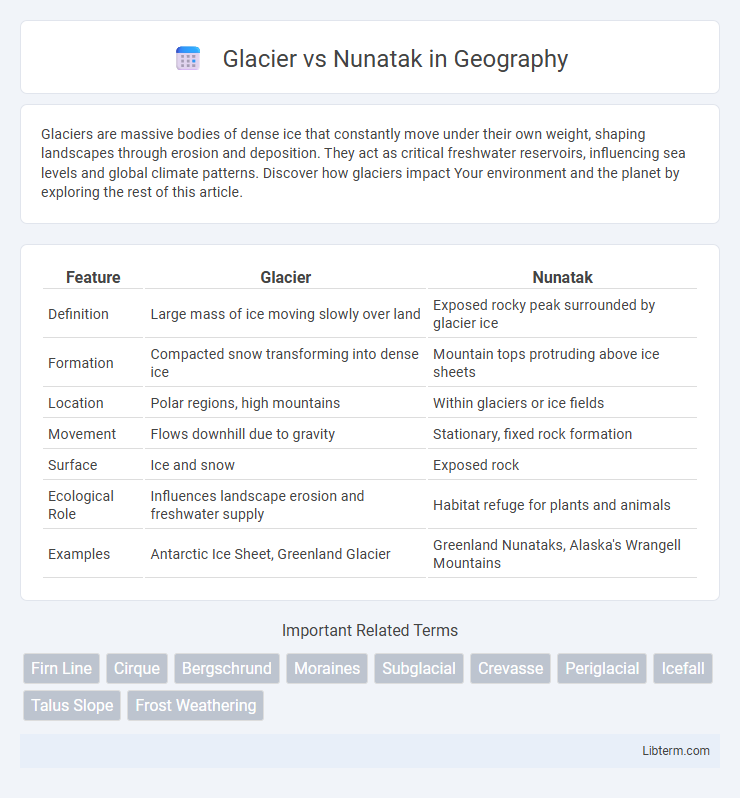Glaciers are massive bodies of dense ice that constantly move under their own weight, shaping landscapes through erosion and deposition. They act as critical freshwater reservoirs, influencing sea levels and global climate patterns. Discover how glaciers impact Your environment and the planet by exploring the rest of this article.
Table of Comparison
| Feature | Glacier | Nunatak |
|---|---|---|
| Definition | Large mass of ice moving slowly over land | Exposed rocky peak surrounded by glacier ice |
| Formation | Compacted snow transforming into dense ice | Mountain tops protruding above ice sheets |
| Location | Polar regions, high mountains | Within glaciers or ice fields |
| Movement | Flows downhill due to gravity | Stationary, fixed rock formation |
| Surface | Ice and snow | Exposed rock |
| Ecological Role | Influences landscape erosion and freshwater supply | Habitat refuge for plants and animals |
| Examples | Antarctic Ice Sheet, Greenland Glacier | Greenland Nunataks, Alaska's Wrangell Mountains |
Introduction to Glaciers and Nunataks
Glaciers are massive, persistent bodies of dense ice constantly moving under their own weight, shaping landscapes through erosion and deposition. Nunataks are exposed, often rocky peaks projecting above glaciers or ice sheets, serving as vital ecological refuges in glacial environments. Understanding glaciers involves studying ice accumulation, flow dynamics, and climate impact, while nunataks provide insights into geological history and biodiversity isolated by ice coverage.
Defining Glaciers: Formation and Characteristics
Glaciers form through the accumulation and compaction of snow over centuries, creating massive, persistent bodies of dense ice that flow slowly under their own weight. Characterized by their movement and ability to reshape landscapes, glaciers play a crucial role in freshwater storage and global climate regulation. Nunataks, in contrast, are exposed rocky peaks that protrude above glaciers or ice sheets, serving as isolated habitats and geological markers within glacial environments.
Understanding Nunataks: Origins and Features
Nunataks are exposed rocky peaks that protrude above surrounding glaciers or ice sheets, serving as vital ecological refuges and geological landmarks. They form when ice sheets retreat or fail to cover higher elevations, revealing ancient rock formations distinct from the glacial environment. Nunataks provide valuable insights into past glacial extents, climate change, and biodiversity within polar and alpine ecosystems.
Key Differences Between Glaciers and Nunataks
Glaciers are massive, persistent bodies of dense ice that flow under their own weight, shaping landscapes through erosion and deposition. Nunataks are exposed, often rocky peaks or ridges protruding above surrounding glaciers or ice fields, serving as isolated habitats for specialized flora and fauna. Unlike glaciers, which are dynamic ice masses, nunataks represent stable landforms that provide crucial geological and ecological insights in glaciated regions.
Geological Significance of Glaciers
Glaciers play a crucial role in shaping Earth's geology by eroding bedrock, transporting sediments, and sculpting landforms such as valleys and fjords. Unlike nunataks, which are isolated mountain peaks protruding through ice sheets and serving as refuges for plant and animal life during glacial periods, glaciers actively modify the landscape beneath and around them. The geological significance of glaciers includes influencing sea level changes, soil formation, and the creation of sedimentary deposits critical for understanding past climate conditions.
Ecological Importance of Nunataks
Nunataks serve as critical ecological refuges, providing isolated habitats for unique plant and animal species often absent from glacial environments. Their exposed rock surfaces allow colonization by lichens, mosses, and specialized invertebrates, contributing to biodiversity hotspots within otherwise inhospitable ice-covered regions. These isolated ecosystems support genetic diversity and act as natural laboratories for studying adaptation and survival in extreme climatic conditions.
Glaciers and Nunataks in Climate Science
Glaciers serve as critical indicators of climate change, with their advance and retreat providing tangible data on global temperature fluctuations and precipitation patterns. Nunataks, exposed rocky peaks protruding through ice sheets, offer unique ecological niches and valuable geological records that help scientists reconstruct past climate conditions. Understanding the interplay between glaciers and nunataks enhances climate models by revealing how ice dynamics influence and respond to environmental shifts.
Human Exploration and Research in Glacial and Nunatak Regions
Human exploration in glacial regions centers on studying ice dynamics, climate change, and glacial geology, with scientists conducting ice core drilling and monitoring glacier movement to understand historical climate patterns. Nunataks, exposed rocky peaks surrounded by ice, serve as critical research sites for biodiversity, geology, and paleoclimate, offering refuge for unique flora and enabling biological and geological studies isolated from surrounding ice fields. Both environments present challenging conditions, requiring specialized techniques and equipment to support scientific missions that enhance knowledge of Earth's cryosphere and climate history.
Challenges Facing Glaciers and Nunataks Today
Glaciers face significant challenges such as accelerated melting due to climate change, resulting in rising sea levels and loss of freshwater reserves. Nunataks, isolated rock outcrops surrounded by ice, struggle with limited biodiversity and habitat fragmentation, impacting endemic species' survival. Both glaciers and nunataks are sensitive indicators of environmental shifts, making their preservation critical for ecological balance and climate monitoring.
Conclusion: The Interplay of Glaciers and Nunataks
Glaciers and nunataks represent dynamic components of glacial landscapes, where glaciers sculpt the terrain through ice movement and erosion, while nunataks serve as resilient, exposed rock peaks that punctuate ice fields. The interplay between glaciers and nunataks influences local biodiversity by providing isolated habitats and affecting glacial flow patterns. Understanding this interaction aids in reconstructing past glacial environments and predicting future glaciological changes amid climate shifts.
Glacier Infographic

 libterm.com
libterm.com